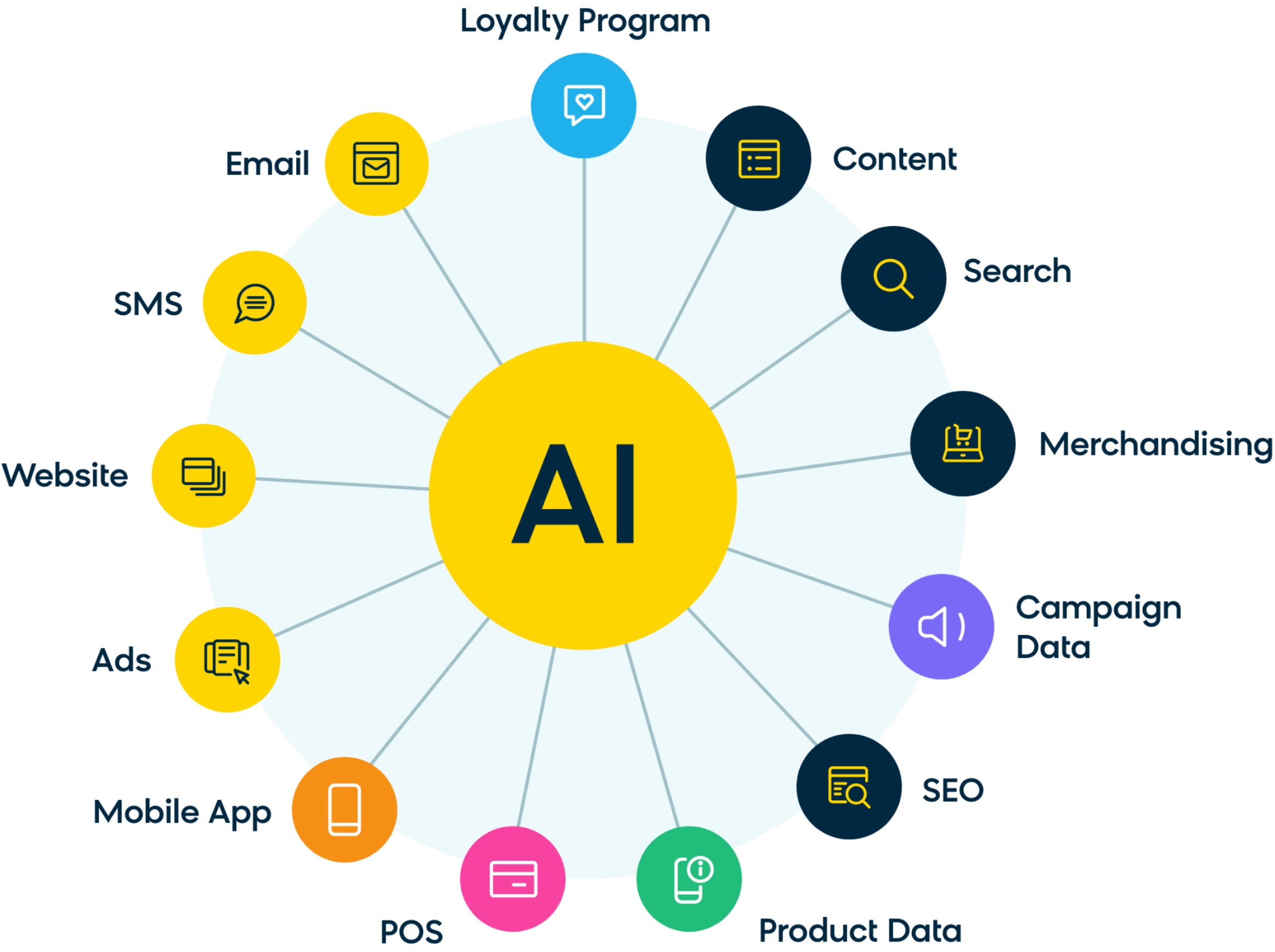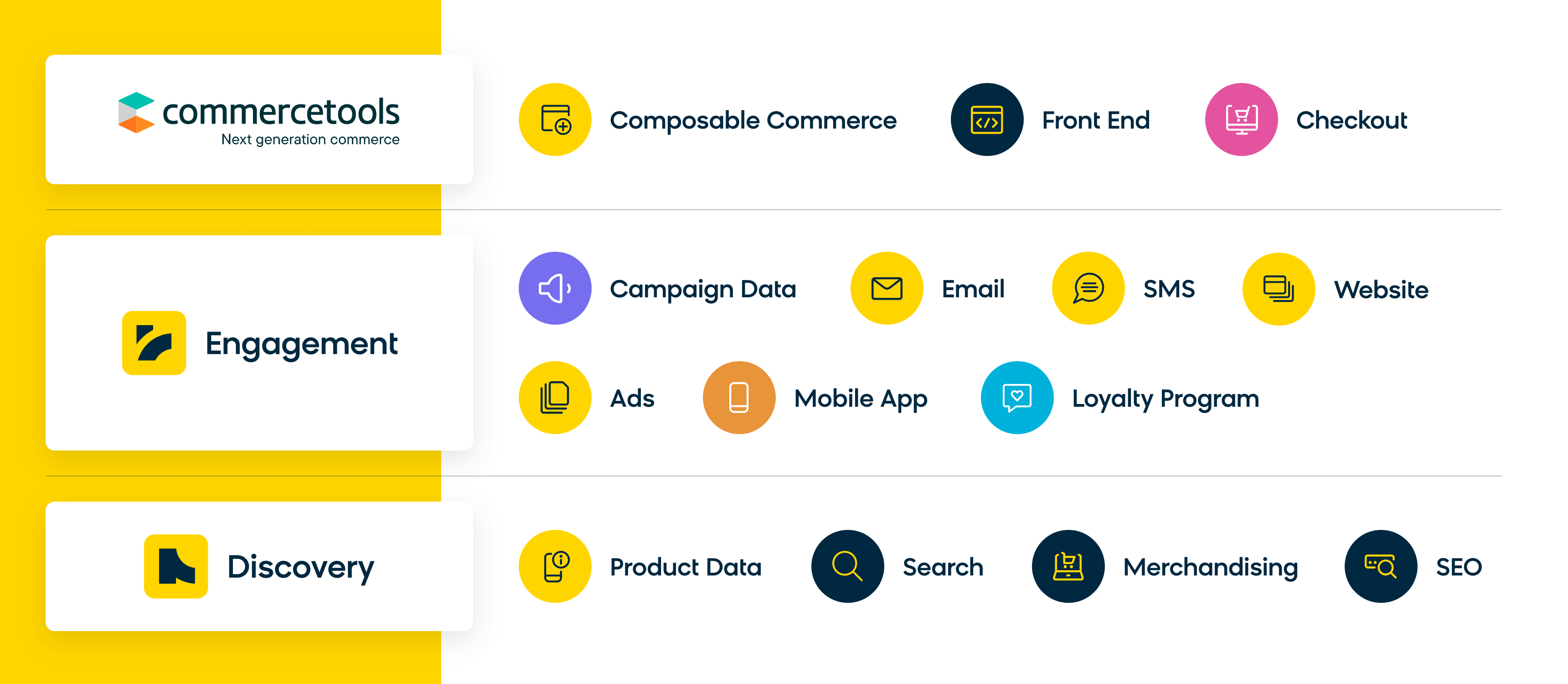Why You Need Composable Commerce To Get the Most Out of AI
By Michael Lee
10/02/2023

AI’s been the buzzword of the year (and will remain a hot topic for years to come), and for good reason. In commerce specifically, AI has proven to be useful in enhancing the customer experience throughout the entire shopping journey while making businesses more efficient.
So, with the recent spotlight on AI technology, organizations everywhere are scrambling to answer the question: How can we use AI for their commerce experiences?
That’s where a composable commerce architecture can help. In our guide, created in partnership with composable commerce platform commercetools, you’ll learn more about what composable commerce is and how it can help you get more out of AI for your business.
An Overview of Composable Commerce
Before delving into composable commerce, it’s important to first understand where ecommerce businesses started from. In the early days of ecommerce, companies favored monolithic, one-size-fits-all architecture because it got them up and running quickly with easy access to all classic ecommerce features in one place.
However, because the customer-facing front end and the commerce-driving back end were so intrinsically linked and inflexible, any changes or updates to the ecommerce system required heavy IT and developer involvement, which led to backlogs and slow rollouts.
Then, as the digital landscape started quickly evolving and more channels were added to the shopping journey (e.g., email, SMS, social media, etc.), monolithic architectures became increasingly unwieldy and were unable to keep up with modern customers. It was clear that a single vendor couldn’t provide all the solutions necessary to meet the rapidly changing consumer demands and behaviors in an omnichannel world.
And that brings us back to composable commerce. A composable commerce approach allows businesses to assemble best-in-class technologies from various vendors, and then compose (i.e., customize) them to meet their unique business needs. In this way, you can create a truly cohesive ecommerce ecosystem that gives customers what they want (and need) from an online shopping experience with a flexible, scalable, and agile tech stack.

The MACH Angle
One of the challenges of assembling your technology stack based on best-of-breed solutions, though, is knowing which ones to pick. That’s where the MACH Alliance comes in. This not-for-profit, vendor-neutral industry body finds the best enterprise technologies that adhere to specific standards:
- Microservices — Individual pieces of business functionality that are independently developed, deployed, and managed, allowing for maximum flexibility
- API-first — All functionality is exposed through an API so that you can tie two or more applications or services together
- Cloud-native SaaS — This software-as-a-service uses the cloud to full advantage, going beyond storage and hosting to include elastic scaling and automatic updates
- Headless — The front-end user experience is decoupled from the back-end logic, giving you complete freedom and agility in framework and programming language

Companies that are part of the MACH Alliance have been vetted to ensure they can provide the scalability and flexibility needed to navigate a changing commerce landscape. Make sure you check out MACH-certified technologies to get the best composable experience possible.
How AI Factors Into Composable Commerce
So, what does AI have to do with composable commerce? Consider the fact that 92% of companies are looking at AI for personalization, and that data-driven personalization can deliver 5-8x the ROI on marketing spend. That means you’ll need to adopt AI technology if you hope to keep up with consumer expectations around personalization and efficiency.
In a composable commerce framework, it becomes considerably easier to integrate AI into your tech stack because you can integrate AI applications with ease and try them out without disrupting your daily operations. You can start small or completely replatform — either way, you get to choose the right AI-driven technology to help you get a leg up in the current marketplace instead of waiting for your dev team to overhaul your monolithic architecture.
That agility enables your organization to deliver more seamless and personalized experiences for your customers.
AI Use Cases in Composable Commerce
We’ve all seen ChatGPT in the news, and while content generation is a great way to use AI, it’s definitely not the only one. Here are some common AI use cases that you can add to your organization with composable solutions:
Content Generation
Let’s start with the easy one. Content generation has been one of the most common use cases for generative AI, and for good reason. AI can help generate ideas, write marketing copy and product descriptions, and more — all within seconds.
Adding solutions that integrate with ChatGPT or other generative AI tools will give your teams the ability to scale up quickly and be more efficient. It’s also useful for creating variations for A/B testing.

Product Recommendations
71% of consumers expect companies to deliver personalized interactions, and they get frustrated when it doesn’t happen. That means it’s no longer enough to send a generic blast of product recommendations to your entire customer base — you need to use AI to deliver truly personalized recommendations at scale.
By collecting and analyzing vast amounts of data, AI can make relevant recommendations in real time, resulting in 1:1 personalization that simply isn’t possible to do manually.
Site Search and Merchandising
Your website is another great way to personalize the shopping experience. Whether your site visitors like to use the search bar or simply browse, you can use AI-driven composable commerce product discovery solutions to address their needs.
Too often, site visitors try using search functionality only to find irrelevant, or even worse, null results. That’s because traditional site search often uses simple keyword matching, which can lead to a broader set of results that don’t quite match the search intent. Or, if the product names and descriptions don’t match the query exactly, it can lead to no results showing up. This leads to a frustrating experience that can drive your potential customers away.
But with AI-powered search, you can deliver more tailored results to search queries. This is made possible through natural language processing (NLP) and semantic understanding, which can break down search queries to understand each part and how they relate to one another. For example, a search for “chocolate milk” should show different results than a search for “milk chocolate.” You can also utilize AI to automatically personalize other aspects of your search results, such as the product images or the types of products.

On the merchandising side, you’ll want an AI-powered solution that can automate manual tasks and free up your merchandisers to focus on more important tasks, such as setting the right boost and bury rules so the AI can better address seasonality or timeliness, cater to global vs. local trends, and highlight specific attributes.
Inventory Management
Managing inventory levels is an excellent way to manage costs and risk for ecommerce businesses. Tools that leverage AI can help with demand forecasting, where you analyze historical sales data (among other factors) to provide accurate predictions for future shipments.
You can also integrate AI with supply chain systems to automatically order new stock and optimize inventory. This helps reduce waste, prevent out-of-stock results, and boost efficiency.
Loss Prevention
Chargebacks, fraudulent activity, and ecommerce returns can result in huge losses for your company. To address these issues, AI solutions are a great fit — they can look at customer behavioral data and transactions to identify patterns and find potential fraudulent activity. AI can also automatically assign risk scores based on previous behavior to help you flag high-risk customers.
For product returns, AI can help optimize the shopping process to proactively address why people are returning items. For example, if your software detects that someone’s buying multiple items in different sizes, you can automatically display a sizing chart to help them choose only the one they need.

Chatbots
AI-powered chatbots represent a new way to engage your customers. Unlike traditional chatbots, which use predefined rules and responses, AI chatbots use conversational commerce to drive more natural interactions. You can see this in action to some degree with ChatGPT already, but there’s a lot of potential for new applications, including shopping-as-a-service tools that can guide your customers through an entire shopping journey — all automatically and in real time.
With a composable commerce approach, you’ll be able to quickly adopt any new conversational commerce solution and get an edge over your competitors.
Bringing AI and Composable Commerce Together With Ease
We’ve talked about why composable commerce is necessary for modern ecommerce, as well as how AI can craft better experiences across the entire customer journey. But there’s still another challenge: If you’re haphazardly bringing together various point solutions, your data may not properly connect and you’ll end up with disjointed customer experiences. For example, if a customer already ordered a product on your website, it’s not ideal to send an email the next day recommending the same product.
With so many ways that AI can integrate into your ecommerce ecosystem, it can be overwhelming to know where to start.

That’s why it’s so crucial to find the right composable solutions for your organization. With the combination of commercetools and Bloomreach, you’ll be able to cover a wide range of ecommerce use cases without worrying about not having unified data or having the most advanced AI technology.
As a founding member of the MACH Alliance, commercetools serves as the perfect foundation to build your composable commerce tech stack on top of. With modern development building blocks in a true cloud-native platform, you’ll be able to launch your ecommerce experiences much faster while also saving on IT costs. Plus, you can build out a front-end storefront and add checkout processes as well to power your online business.
Then, add Bloomreach — which is also MACH-certified — on top of commercetools to cover the other aspects of your ecommerce business. With Bloomreach Discovery, you get AI-powered product discovery, including personalized site search, intelligent merchandising insights, and automated SEO. The AI is trained on over 13 years of ecommerce data, resulting in one of the most robust datasets out there. This gives you an immediate advantage right from the start (instead of waiting for a pixel to learn), and drives faster ROI than any other product discovery solution on the market.
Bloomreach Engagement, meanwhile, unifies your customer data, so that you can connect your campaigns across every channel. With a powerful customer data engine that drives real-time personalization that’s consistent across channels, you never have to worry about providing an irrelevant experience for your customers.

Embracing the Future of Ecommerce
The best part about using commercetools + Bloomreach is that it’s completely composable. With monolithic platforms, you have to undergo a costly and time-consuming replatforming process before you can use them. But with composable commerce, you can start small by adding in the most urgent solutions you need and then growing from there.
That means you can start embracing innovative AI technologies today with minimal effort and risk. With AI solutions evolving at an unbelievably fast pace, it’s imperative to get on board with AI before you get left behind.
Ready to get started with composable commerce and AI? Read up on some best practices for composing your commerce, then check out the various AI use cases available right now for your business.
Found this useful? Subscribe to our newsletter or share it.





